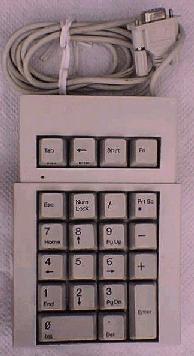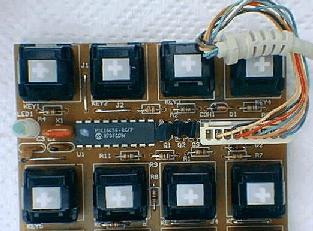Introduction
Protocol
C Program
An Application
Introduction
 The Qtronix Scorpius 22
keypad has the keys found in the "numeric" part of a standard
keyboard. It has an RS-232 interface with a 9-pin connector.
This note describes the keypad, its key codes, and simple application
using the keypad.
The Qtronix Scorpius 22
keypad has the keys found in the "numeric" part of a standard
keyboard. It has an RS-232 interface with a 9-pin connector.
This note describes the keypad, its key codes, and simple application
using the keypad.
The keypad is available from Jameco for $39.95 in their catalog #993.
The unit evaluated was purchased from a local store (T-Zone) for 22
dollars.
Auxiliary keypads are also available which plug in-line with a normal
keyboard using a PS2 style connector. These units are a better choice
if you really want a numeric keyboard for your console or X-window
applications. Currently serial devices can not be conveniently used
as auxiliary keyboards under Linux
A PIC 17C54 is at the heart of the keypad. The modem control lines
on the serial port supply power for the 17C54 and the green NumLock
LED. The photo below is of the circuitry in the keypad.

Protocol
It looks like the keypad uses RTS and DTR to power the serial
port. DTR needs to be set to +12 volts and RTS must be set
to -12 volts. The port should be configured for 8 data bits,
no parity, and one stop bit (8,N,1) at 9600 baud.
The unit sends a single byte for each keystroke. The keypad
has three modifier keys: Shift, Fn, and NumLock. NumLock is modal
with a green LED to indicate state. Fn and Shift are chord keys like
the shift key on most keyboards. The table
below shows the key codes for all keys for each of the modifiers.
| Keypad Key Codes (in hex) |
| Key | | Fn | Num | Shift |
| * | 83 | 83 | 83 | ac |
| + | 93 | 93 | 93 | 93 |
| - | 92 | 92 | 92 | 92 |
| . | 9f | 9f | 90 | 90 |
| / | 95 | 95 | 95 | 95 |
| 0 | 9e | aa | 8e | 8e |
| 1 | 9a | a6 | 8a | 8a |
| 2 | 96 | a0 | 84 | 84 |
| 3 | 9b | a7 | 8b | 8b |
| 4 | 97 | a1 | 85 | 85 |
| 5 | b2 | a4 | 88 | 88 |
| 6 | 98 | a2 | 86 | 86 |
| 7 | 9c | a8 | 8c | 8c |
| 8 | 99 | a3 | 87 | 87 |
| 9 | 9d | a9 | 8d | 8d |
| BkSp | 89 | a5 | 89 | 89 |
| Enter | 94 | 94 | 94 | 94 |
| Esc | 91 | 91 | 91 | 91 |
| Tab | 8f | ab | 8f | ad |
C Program
The following C program opens the port, sets the modem control lines
and reads a single keystroke from the keypad. The output is a two
character hex number which represents the keycode.
/* keypad : reads a single key code from a Qtronix serial keypad */
/* Usage: keypad <serial port> */
/* eg: keypad /dev/ttyS0 */
#include <stdio.h>
#include <termio.h>
#include <sys/fcntl.h>
main (int argc, char *argv[])
{
struct termios tbuf;
int fd_dev;
int sm; /* state of the modem lines */
unsigned char buf;
if (( fd_dev = open(argv[1], (O_RDWR | O_NDELAY), 0)) < 0 ) {
printf("Unable to open tty port specified\n");
exit(1);
}
tbuf.c_cflag = CS8|CREAD|B9600|CLOCAL;
tbuf.c_iflag = IGNBRK;
tbuf.c_oflag = 0;
tbuf.c_lflag = 0;
tbuf.c_cc[VMIN] = 1; /* character-by-character input */
tbuf.c_cc[VTIME]= 0; /* no delay waiting for characters */
if (tcsetattr(fd_dev, TCSANOW, &tbuf) < 0) {
printf("%s: Unable to set device '%s' parameters\n",argv[0], argv[1]);
exit(1);
}
if (( fd_dev = open(argv[1], (O_RDWR), 0)) < 0 ) {
printf("Unable to open tty port specified\n");
exit(1);
}
sm = TIOCM_DTR;
if(ioctl(fd_dev, TIOCMBIS, &sm) == -1) {
printf("Unable to set modem control lines\n");
exit(1);
}
read(fd_dev, &buf, 1);
printf("%02x\n", buf);
exit(0);
}
An Application
This is a description of the author's use of the Qtronix serial keypad.
One of my PCs boots from a SanDisk flash disk into OpenDOS and then into
loadlin and Linux. The root file system is on a RAM disk. There are no
fans on the CPU or power supply so the computer has no moving parts.
This machine is meant to be less a PC and more an appliance.
It has a modem, printer, Palm Pilot cradle, and a text-to-speech board,
as well as the CD-writer and other I/O devices.
It does not have a monitor or keyboard.
The serial keypad is used to set-up ('7') and tear-down ('8') a PPP link to
my ISP. If "NumLock" is on, the command about to be executed is spoken
by the text-to-speech board. The '4' key is used to speak the time.
| The keypad.sh script file |
#!/bin/bash
# A script to read a Qtronix serial keypad and
# execute commands based on the key pressed.
# 'NumLock' usually implies a spoken response
while true
do
# Sleep waiting for a keypress
KEY=`./keypad /dev/ttyS4`
case $KEY in
85 | 97 ) # Either '4' or 'NumLock 4'
speak `date +%k%t%M`
;;
88) # Both '5' and 'NumLock 5'
speak `/usr/local/bin/temperature` degrees
;;
9c) # '7' key
/usr/sbin/dip .aim
;;
8c) # 'NumLock 7' key
speak "Setting up P P P link"
speak `/usr/sbin/dip .aim`
;;
99) # '8' key
/usr/sbin/dip -k
;;
87) # 'NumLock 8' key
speak "Tearing down P P P link"
speak `/usr/sbin/dip -k`
;;
*)
echo $KEY is not implemented
;;
esac
done
|
 The Qtronix Scorpius 22
keypad has the keys found in the "numeric" part of a standard
keyboard. It has an RS-232 interface with a 9-pin connector.
This note describes the keypad, its key codes, and simple application
using the keypad.
The Qtronix Scorpius 22
keypad has the keys found in the "numeric" part of a standard
keyboard. It has an RS-232 interface with a 9-pin connector.
This note describes the keypad, its key codes, and simple application
using the keypad.
